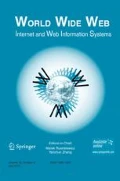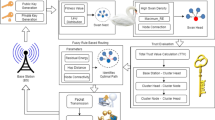Abstract
Fog and Cloud computing are ubiquitous computing paradigms based on the concepts of utility and grid computing. Cloud service providers permit flexible and dynamic access to virtualized computing resources on pay-per-use basis to the end users. The users having mobile device will like to process maximum number of applications locally by defining fog layer to provide infrastructure for storage and processing of applications. In case demands for resources are not being satisfied by fog layer of mobile device then job is transferred to cloud for processing. Due to large number of jobs and limited resources, fog is prone to deadlock at very large scale. Therefore, Quality of Service (QoS) and reliability are important aspects for heterogeneous fog and cloud framework. In this paper, Social Network Analysis (SNA) technique is used to detect deadlock for resources in fog layer of mobile device. A new concept of free space fog is proposed which helps to remove deadlock by collecting available free resource from all allocated jobs. A set of rules are proposed for a deadlock manager to increase the utilization of resources in fog layer and decrease the response time of request in case deadlock is detected by the system. Two different clouds (public cloud and virtual private cloud) apart from fog layer and free space fog are used to manage deadlock effectively. Selection among them is being done by assigning priorities to the requests and providing resources accordingly from fog and cloud. Therefore, QoS as well as reliability to users can be provided using proposed framework. Cloudsim is used to evaluate resource utilization using Resource Pool Manager (RPM). The results show the effectiveness of proposed technique.












Similar content being viewed by others
References
Berlingerio, M., Coscia, M., Giannotti, F., Monreale, A., Pedreschi, D.: Multidimensional networks: foundations of structural analysis. World Wide Web. 16(5–6), 567–593 (2013)
Bhatia, M., Sood, S.K.: Game theoretic decision making in IoT assisted activity monitoring of defence personnel. Multimedia Tools and Applications. (2017). https://doi.org/10.1007/s11042-017-4611-3
Bo, Z., Shuang, X., Yang, A., Wei, T.: DPTSV: a dynamic priority task scheduling strategy for TSS deadlock based on value evaluation. China Communications. 13(1), 161–175 (2016)
Cao, J., Wu, Z.: An improved protocol for deadlock and Livelock avoidance resource co-allocation in network computing. World Wide Web. 13(3), 373–388 (2010)
Chen, J.N., Chen, P.: Diagnosis system for automatic detection of deadlock in asynchronous concurrent distributed computing systems: using timed petri net with stacks. In: Annual International Computer Software and Applications Conference, pp. 658–664 (1990) https://doi.org/10.1109/CMPSAC.1990.139456
CloudSim. http://www.cloudbus.org/cloudsim/ (2017). Accessed 1 Oct 2017
Dastjerdi, A.V., Buyya, R.: Fog computing: helping the internet of things realize its potential. Computer. 49(8), 112–116 (2016)
FreeMat. http://freemat.sourceforge.net/ (2017). Accessed 1 Oct 2017
He, S., Wang, Y., Sun, X.H., Xu, C.: Using MinMax-memory claims to improve in-memory workflow computations in the cloud. IEEE Trans. Parallel Distrib. Syst. 28(4), 1202–1214 (2017)
Lim, J., Suh, T., Yu, H.: Unstructured deadlock detection technique with scalability and complexity-efficiency in clouds. Int. J. Commun. Syst. 27(6), 852–870 (2014)
Liu, G., Liu, Y. et al.: Context-aware trust network extraction in large-scale trust-oriented social networks. World Wide Web. (2017). https://doi.org/10.1007/s11280-017-0485-6
Mahitha, O., Suma, V.: Deadlock avoidance through efficient load balancing to control disaster in cloud environment. In: International Conference on Computing, Communications and Networking Technologies, pp. 1–6 (2013) https://doi.org/10.1109/ICCCNT.2013.6726823
NetLogo. https://ccl.northwestern.edu/netlogo/5.1.0/ (2017). Accessed 1 Oct 2017
Nguyen, H.H.C.: Deadlock prevention for resource allocation in heterogeneous distributed platforms. Frontiers Artificial Intelligence Appl. 282, 40–49 (2016)
Quesnel, F., Lèbre, A., Südholt, M.: Cooperative and reactive scheduling in large-scale virtualized platforms with DVMS. Concurrency Computation Pract. Experience. 25(12), 1643–1655 (2013)
Sandhu, R., Kaur, H., Sood, S.K.: Smart monitoring and controlling of pandemic influenza a (H1N1) using social network analysis and cloud computing. J. Comput. Sci. 12, 11–22 (2015)
Seo, D., Kim, S., Song, G.: Mutual exclusion method in client-side aggregation of cloud storage. IEEE Trans. Consum. Electron. 63(2), 185–190 (2017)
Sood, S.K.: Function point based resource prediction in cloud. Concurrency Computation: Pract. Experience. 28, 2781–2794 (2016)
Wang, Y., Hu, M., Kent, K.B.: ACS: an effective admission control scheme with deadlock resolutions for workflow scheduling in clouds. Computing. 97(4), 379–402 (2015)
Yoginath, S.B., Perumalla, K.S.: Efficient parallel discrete event simulation on cloud/virtual machine platforms. ACM Trans. Model. Comput. Simul. 26(1), 1–26 (2015)
Zhang, C.F., Zha, Y.B., Liu, Y.S., Zhang, T.H.: Method and simulation of deadlock free resource co-allocation in simulation-grid. J. Syst. Simul. 18(9), 2588–2592 (2006)
Zin, N.M., Noraziah, A., Abdalla, A.N., CheFauzi, A.A.: Solving two deadlock cycles through neighbor replication on grid deadlock detection model. J. Comput. Sci. 8(2), 265–271 (2012)
Author information
Authors and Affiliations
Corresponding author
Additional information
This article belongs to the Topical Collection: Special Issue on Deep Mining Big Social Data
Guest Editors: Xiaofeng Zhu, Gerard Sanroma, Jilian Zhang, and Brent C. Munsell
Rights and permissions
About this article
Cite this article
Sood, S.K. SNA based QoS and reliability in fog and cloud framework. World Wide Web 21, 1601–1616 (2018). https://doi.org/10.1007/s11280-018-0525-x
Received:
Revised:
Accepted:
Published:
Issue Date:
DOI: https://doi.org/10.1007/s11280-018-0525-x




